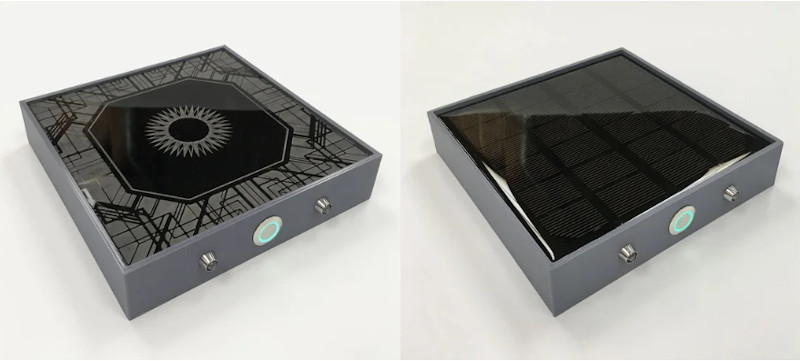Charging pads are now a common, popular way to charge small devices. They have the benefit of reducing wear on connectors and being easier to use. [bcschmi6] decided to build a solar powered charging pad, which should come in handy when out and about.
The build uses a 3 W square solar panel, hooked up to an Adafruit solar charging board. This charges a pair of 18650 lithium batteries. The batteries only put out a maximum of 4.2 V, so they’re hooked up to a boost converter to get the output a little higher, up to 5.2 V. The output of the boost converter is then hooked up to a charging pad harvested from an Anker charger, and it’s all wrapped up in a tidy 3D printed frame.
We imagine the device would be great for camping. It could be left charging in the sun during the day, before being flipped over and used as a charging pad at night. It would be easy to build a bigger version for charging several phones at once, too. If you want to build your own charging coils, that’s a thing, too. And if you’ve got your own solar project cooking up as we head into summer, be sure to let us know!
















Really nice project, well done. Just wondering how the 500ma at 5v boost converter keeps up with the 1A+ power draw from the charger?
Adafruit’s page says it’s good for *at least* 500 mA, but that it can generally 1A and maybe even a bit more.
Cool idea and great execution, but this looks more like a windowsill device than a camping accessory. An optimistic 3W will barely keep your headlamp charged.
For DIY camping, consider a few 25W harbor freight panels hooked up to a spare car battery. Packs of 4 are on sale for like $200 from time to time, and those include stands and a basic charge controller. They’re amorphous panels, so they still gather a modicum of energy on cloudy/rainy days (when you’ll want power the most), and they are durable enough to survive highway vibrations, small bits of falling debris, freeze/hot cycles, etc. They also have M5 mounting holes and are well-sized for car roof rails.
Plus, a spare car battery can also power an inverter for AC chargers, and in a pinch it can even jump-start a car!
A 3 Watt panel may generate around 7-8 Watt-hours per day. More if it gets direct sunlight for at least three hours, but the inefficiency of the rest of the components will eat a considerable chunk. You get half a battery full for your cellphone.
Solar panels work really poorly with ambient light, and cloudy/rainy days literally get 10-1000 times less anyways, so any solar charger is basically useless with anything but direct sunlight.
In a pinch? that’s kinda it’s day job :-P
The solar chargers distributed in India for the rural populations had a day job of charging up a lamp and a cellphone, and they were designed with 40 Watt panels. That’s about the right size for the job.
Unfortunately, since the rural Indian people aren’t exactly college educated electrical hackers and maintenance of the chargers was relying on imported parts, nearly all the solar lights went missing, stolen, or broken within two years. Kinda like the OLPC, high-tech solutions don’t really work on deep seated socioeconomic issues – they’re mainly just ways to keep charity organizations and undergrads/hackers designing the equipment busy.
When the instructable consistently quotes a charge rate of “500 mAh”, you immediately have an indication of the quality of the engineering involved.
I wonder what use case would justify something like this. Even assuming you can trust the sun to be out, and you can can leave this thing in the sun all day, and it doesn’t cook itself, and you babysit it to optimally track the sun, you can (under perfect conditions) expect a maximum of about 3 Ah into the batteries per day. (So the choice of a pair of “3000” (pseudo-)mAh cells is good: about a half charge maximum.)
So, on discharge, you’ll get 10 Wh on a good day.
After the boost converter, you’ll get about 8 Wh at 5V. Assuming it can keep up with the Anker’s current drain (it won’t with my Qi charger, which draws 2A when charging my phone), and using Qi’s own numbers, you’ll get 60% of that energy out the other end, or 4.8 Wh per (good) day.
This thing is around 15 x 15 x 3 cm in size, is not terribly light, and cost probably over $100 in parts. For a lousy 4.8 Wh per day, assuming you can babysit the thing all day. Your average dollar store USB charger provides the same energy, is a tenth the weight, a fiftieth the cost, and doesn’t need to sit in the sun all day.
Also, strange there’s no provision to charge it via USB, considering there’s a handy USB socket right on that charge controller board.
You hit the nail on the head nice and square with that last point. The rest is true, but not a problem for the right usecases – I’ve had a cheap solar USB battery bank for years now, never tried to take it apart or benchmark it fully. But it would sit on my bags carry handle adding almost nothing to the 10+KG bag I used to lug around (School books, weighty laptop from eons ago, Lunch(the important part)) and it was there fully charged when I needed it. Could it work for daily charging of my PDA/Phone thing not a chance, but as a backup for those days you worked the device hard (which usually meant flat laptop & no handy socket) or forgot to charge it for a few days it was handy.
Thanks for sharing this useful post..